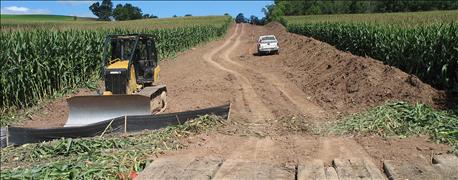November 17, 2015

The buildout from natural gas fields of northern and southwestern Pennsylvania will have a direct impact on farmland all across the state. During pipeline easement negotiations, ag landowners should be asking for compensation for crops damaged during pipeline construction.
Related: Initial Pa. natural gas pipeline report cites huge land-use impact
Here's a quick tutorial for calculating a potential damage payment. We use the term 'potential damage payment', since the final payment will be determined via negotiation with the company land agent or 'landman'.
The basic formula is: Lost yield x commodity price x disturbed acres = Potential damage payment.

CROP DAMAGE PAYMENT DUE: Pipeline easement negotiations must include potential crop loss payments for multiple years. Make certain it's clearly written into the easement agreement before you sign it. Photo by Penn State Extension/ Mark Madden
Some land agents will accept any reasonable crop damage estimate; others may use your damage estimate as a starting point for negotiation. Whatever the agreed-upon damage payment is, make sure the amount is provided to you in writing before signing the agreement.
Determining multi-year yield losses
Lost yield, or expected crop yield, is ideally calculated from your farm records. Since you're trying to determine an expected yield, it's reasonable to use a recent running average for the farm or the impacted field – excluding atypical years such as drought or flood. If you're struggling to determine a reasonable expected crop yield, your local Extension educator may be able to provide some guidance.
During pipeline negotiations, it's common to assume full crop loss during the construction year, and then some yield drag over the right-of-way for several years afterwards. It's common on restored sites due to soil disturbance and compaction.
Many people have used a '100%-50%-25% formula' as described below. For our example, we'll use a corn field with a documented five-year average yield of 175 bushels per acre. Figure a full loss during the year of construction, 50% loss the second year, 25% loss the third year, plus no loss accounted for in years four and beyond.
So our total yield lost is: Total lost yield: 175 bu. + 87.5 bu. + 43.8 bu. = 306.3 bu. per acre
Pick a commodity price
Commodity prices are, of course, vary over time. It's up to the landowner to pick a realistic commodity price as a starting point for the negotiation with the landman.
~~~PAGE_BREAK_HERE~~~
You could choose to use the current market price, a futures price for the anticipated date of pipeline construction, an average historical price or some combination of them. Regardless of which price you use, be sure you can provide justification for the price if requested. For our example, we'll use a current December 2016 futures price of $4.08 per bushel.
Calculating the impacted acreage
Before calculating impacted acreage, it's important to understand the difference between the permanent easement and the temporary construction easement. Impacted acreage can be determined by: [length x width in feet] divided by 43,560. (An acre contains 43,550 square feet.)
The permanent easement describes the width of the final restored property easement. Permanent easements generally are 50 feet wide; although they can vary significantly from pipeline to pipeline.
The construction easement indicates the width that'll be disturbed by excavation or heavy equipment during construction. For the purposes of crop damage estimates, we want to use the construction easement width – the area initially disturbed (or damaged) during pipeline construction.
A 'typical' construction easement is 100 feet' wide. But be sure to ask the landman (and make sure it's in the contract) because these widths can vary.
For this example, the easement acreage that's 2,000 feet long with a construction width of 100 feet is 4.59 acres. So the impacted acreage is: [2,000 x 100] divided by 43,560 = 4.59 acres
Calculating final potential damage payment
So our final potential damage estimate calculation is: Lost yield x commodity price x disturbed acres.
Using the above data, that potential damage payment is: 306.3 bu. x $4.08 x 4.59 acres = $5,736.14.
This is only an example. Your crop damage calculation should be based on your farm or impacted field. Remember, it's subject to negotiation with your landman.
For more about pipelines and rights of way visit: Negotiating Pipeline Rights of Way in Pennsylvania.
Messersmith, [email protected], is a member of Penn State Extension's Marcellus Education Team.
You May Also Like




